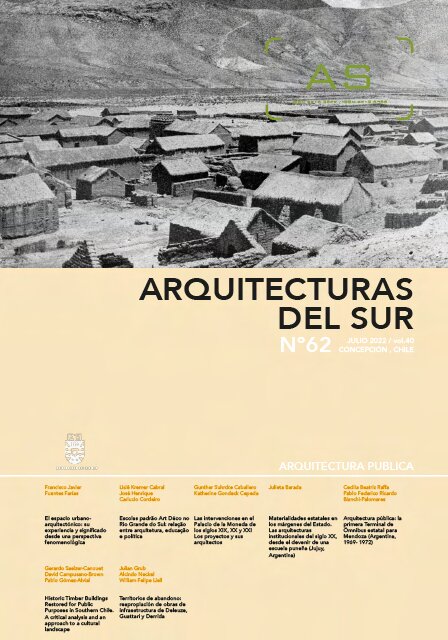Art Deco Standard Schools in Rio Grande do Sul: the relationship between architecture, education, and politics
DOI:
https://doi.org/10.22320/07196466.2022.40.062.02Keywords:
Art Deco, school architecture, modern architecture, culture policies, nationalismAbstract
The project of schools built following the Art Deco architectural style, which were built between the 1930s and 1940s in the state of Rio Grande do Sul, Brazil, intended, starting from the characteristics of the built environment, to transmit the ideals of the authoritarian government of Getúlio Vargas, during the New State (Estado Novo) period. Given architectural, political, and educational requirements, the formal and functional aspects of these establishments focused on controlling student behavior and exalting State power, as a symbol of progress and order. The purpose of this work is to identify how the schools built following the Art Deco style acted as an ideological instrument of the State, through bibliographical and document analysis, and an observation of the built environment, together with a case study made at the Assis State Education Institute, Brazil, located in the south of the country in the city of Pelotas/RS. Through this analysis, it was seen that the integrated school construction, political practices, and teaching methods, grouped and guided students towards a State-proposed ideal model.
Downloads
References
ALVES, G. W. (2011). Políticas de saúde pública no Rio Grande do Sul: continuidades e transformações na era Vargas (1928-1945). Mestrado em História, Faculdade de filosofia e Ciências Humanas, PUCRS, Porto Alegre. http://tede2.pucrs.br/tede2/bitstream/tede/2372/1/430450.pdf
ALVES, N. (1998). O espaço escolar e suas marcas: o espaço como dimensão material do currículo. DP&A.
AMARAL, G. L. & AMARAL, G. L. (2007). Instituto de Educação Assis Brasil: entre a memória e a história 1929-2006. Pelotas: Seiva.
BARDIN, L. (1977). Análise de Conteúdo. Lisboa: Edições 70.
CABRAL, L. K. (2020). Arquitetura Art Déco nas escolas do Rio Grande do Sul no período do Estado Novo (1930-1950). Mestrado em Arquitetura, PROGRAU, Pelotas. https://drive.google.com/file/d/1NuYxlDsqktLj8IgxR3bgZCJsFj2ymoyQ/view
CABRAL, L. K. & CORDEIRO J. C. & OLIVEIRA, A. L. (2020). O patrimônio escolar Art Déco: intervenções na escola Marques de Souza – 1940, São José do Norte/RS. 7º Seminário DOCOMOMO SP.
CABRAL, L. K. & OLIVEIRA, A. L. (2018). O patrimônio escolar protomoderno – Instituto Estadual de Educação Assis Brasil – 1942, na cidade de Pelotas. Simpósio Científico ICOMOS Brasil. Belo Horizonte.
CHAVES, C. (2008). Arquitetura, modernização e política entre 1930 e 1945 na cidade de Belém. Arquitextos, São Paulo, 094.06, ano 08. http://www.vitruvius.com.br/revistas/read/arquitextos/08.094/161.
CORREIA, T. B. (2010). O Art Déco na Arquitetura Brasileira. Revista UFG, Dossiê Art Déco, Ano XII n°8, Goiás, 5 p. https://www.revistas.ufg.br/revistaufg/article/view/48295/23636.
ESCOLANO, A. (2017). A escola como cultura. São Paulo: Alínea.
ESPINOZA, L. (2017). Escuelas: Tradición proyectual en arquitectura pública en Argentina. Arquitecturas del Sur, Vol 35, n° 52, p. 42-53. http://revistas.ubiobio.cl/index.php/AS/article/view/2823
FOUCAULT, M. (2018). Vigiar e punir: Nascimento da prisão. Petrópolis: Vozes.
FOURQUET, F. & MURARD, L. (1978). Los equipa2mentos del poder: Cidades, territórios y equipamentos colectivos. Barcelona: Gustavo Gili, S.A.
FRAGO, A. & ESCOLANO, A. (2001). Currículo, espaço e subjetividade: a arquitetura como programa. Rio de Janeiro: DP&A.
FREIRE, P. (2021). Pedagogia do oprimido. Rio de janeiro: paz e terra, 78 ed.
GURGEL, M. (2011). Projetando espaços: design de interiores. São Paulo: Senac, 4 ed.
KOWALTOWSKI, D. K. (2013). Arquitetura Escolar: o projeto do ambiente de ensino. São Paulo: Oficina de textos.
MANZO, R. (2010). A arquitetura na construção da imagem do Estado Getulista: Rio de Janeiro, 1930/1945. Doutorado em Arquitetura, Mackenzie, São Paulo. http://tede.mackenzie.br/jspui/handle/tede/2565
OLIVEIRA, F. V. (2007). Arquitetura escolar paulista nos anos 30. 2007. Mestrado em arquitetura, USP, São Paulo. http://www.teses.usp.br/teses/disponiveis/16/16133/tde-20052010-152808/pt-br.php
RAMIREZ. W.G. (2017). Pedagogías de una ideología: Arquitectura educativa en Colombia (1994-2016). Arquitecturas del Sur, Vol 35, n° 52, p. 70-83. http://revistas.ubiobio.cl/index.php/AS/article/view/2929
RIBEIRO, M. L. S. (1991). História da educação brasileira: a organização escolar. São Paulo: Cortez.
ROCHA, D. M. M. (2012). A modernidade dos interiores Art Déco em Goiânia. Anais do V Seminário Nacional de Pesquisa em Arte e Cultura Visual. Goiânia, UFG. https://files.cercomp.ufg.br/weby/up/778/o/2012-33_A_modernidade.pdf
SEGAWA, H. (1997). Arquiteturas no Brasil 1900-1990. São Paulo: USP, acadêmica 21.
SILVEIRA JUNIOR, A. (2012). Referência, mídia e projeto: compreendendo a estética da arquitetura protomodernista em Pelotas/RS. Mestrado em Arquitetura, PROGRAU, Pelotas. https://drive.google.com/file/d/1jE9d1QJzCWjoSs90FLN1enXRqj5tXN7e/view
SOMMER, B. & SOMMER, R. (2002). A Pratical Guide to Behavioral Research: tools and techniques. Nova York: Oxford University Press
VALDEMARIN, V. T. (2010). História dos métodos e materiais de ensino: a escola nova e seus modos de uso. São Paulo: Cortez.
VIANA, A. O. (2011). A persistência dos rastros: manifestações do art déco na arquitetura de Florianópolis. Santa Catarina: UDESC.
WEIMER. G. (2004). Arquitetos e Construtores no RS 1892-1945. Santa Maria: UFSM.
WERLE, B. (2014). A campanha de nacionalização e sua memória no alto do Taquari (RS). Mestrado em História, Universidade Federal do Rio Grande do Sul, IFCH, Porto Alegre. https://www.lume.ufrgs.br/handle/10183/88346.
Downloads
Published
How to Cite
Issue
Section
License
Copyright (c) 2022 Lisiê Kremer-Cabral, José Henrique Carlucio-Cordeiro

This work is licensed under a Creative Commons Attribution-ShareAlike 4.0 International License.
The content of the articles published in each issue of Arquitecturas del Sur is the sole responsibility of the authors and does not necessarily represent the opinion of University of the Bío-Bío.
The authors will maintain their copyright; however, they will guarantee the journal the right to first publication and dissemination of their work. The publication of the article in Arquitecturas del Sur will be subject to the Creative Commons International license (CC BY-SA) that allows others to adapt: remix, transform and build on the material for any purpose, even commercially; share: copy and redistribute the material in any medium or format, as long as the authorship and first publication in this journal are acknowledged by citing them correctly, and their new contributions are under a license with the same terms.














 Programa de Información Científica/Concurso Fondos de Publicación de Revistas Científicas 2018/ Proyecto Mejoramiento de Visibilidad de Revistas UBB (Código:FP180007)
Programa de Información Científica/Concurso Fondos de Publicación de Revistas Científicas 2018/ Proyecto Mejoramiento de Visibilidad de Revistas UBB (Código:FP180007) 
